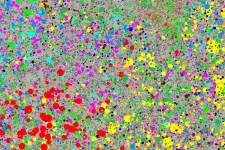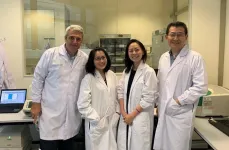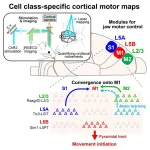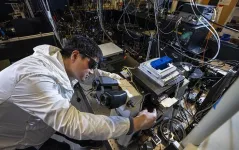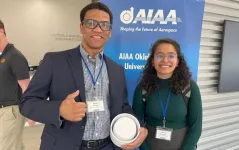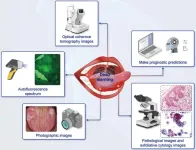(Press-News.org) Immune cells that eat bacteria in the body don’t stash them in specialized compartments as once thought, but turn them into critical nutrients that build proteins, create energy and keep the cells alive, according to a new study from scientists at the University of Colorado Anschutz Medical Campus.
“We are what we eat,” said the study’s co-senior author Angelo D’Alessandro, Ph.D., professor of biochemistry and molecular genetics at the University of Colorado School of Medicine at CU Anschutz. “What we eat changes the composition of us and when immune cells eat bacteria the same thing happens to them.”
The study was published today in the journal Nature.
The researchers also discovered that when these cells, called macrophages, eat live bacteria it triggers an inflammation response. But when they eat dead bacteria it doesn’t.
“When phagocytic cells eat dead bacteria some of the small molecules they recycle tell them not to induce inflammation, that everything is going to be fine,” D’Alessandro said. “But when they eat live bacteria that signal is not there and it can induce inflammation which drives many diseases.”
The scientists delved deeply into the workings of these immune cells to better understand the `switches’ that turn inflammation on and off. They discovered a key protein complex called mTORC1 regulated how macrophages used the nutrients from the bacteria they consumed. They also found that dead bacteria contain a molecule known as cAMP that might tell immune cells that bacteria are dead so they can adjust their metabolism and better control inflammation.
Chronic inflammation can drive everything from cancer and long COVID to chronic fatigue syndrome and shingles. These findings can help scientists and physicians develop therapies to better control this response.
“Over the next 10 years we will be dealing with more antibiotic resistant strains of bacteria,” D’Alessandro said. “Understanding that there are brakes that nature has evolved will help us eliminate or boost this response depending on the circumstances.”
The co-authors include Assistant Research Professor Julie A. Reisz Haines, Ph.D., of CU Anschutz, Parnika Mukherjee, Ph.D., of Charité–Universitätsmedizin Berlin, Germany as well as Juliette Lesbats, Ph.D., and Johan Garaude, Ph.D., of the University of Bordeaux in France.
About the University of Colorado Anschutz Medical Campus
The University of Colorado Anschutz Medical Campus is a world-class medical destination at the forefront of transformative science, medicine, education and patient care. The campus encompasses the University of Colorado health professional schools, more than 60 centers and institutes, and two nationally ranked independent hospitals - UCHealth University of Colorado Hospital and Children's Hospital Colorado - that treat more than two million adult and pediatric patients each year. Innovative, interconnected and highly collaborative, the University of Colorado Anschutz Medical Campus delivers life-changing treatments, patient care and professional training and conducts world-renowned research fueled by over $705 million in research grants. For more information, visit www.cuanschutz.edu.
END
Bacteria consumed by immune cells become part of the cell
CU Anschutz scientists discover that when macrophages eat bacteria it nourishes cells while regulating inflammation response
2025-02-26
ELSE PRESS RELEASES FROM THIS DATE:
CSIC researchers discover how the brain builds sophisticated maps to navigate and remember the world
2025-02-26
The brain creates internal 'maps' to help us navigate and learn from our surroundings, but how these maps form remains a challenge to understand. Now, a study led by Liset M. de la Prida at the Cajal Neurosciences Center (CNC-CSIC) in Madrid, in collaboration with Imperial College London, offers a fresh perspective on how spatial and experiential information is encoded in the hippocampus, a key brain region for navigation and memory.
The study published today in Neuron, reveals that two types of hippocampal ...
New spatial mechanism for the coexistence of tree species
2025-02-26
The data sets are very large: with more than 75 permanent forest dynamics plots in 29 countries worldwide, the Forest Global Earth Observatory network (ForestGEO) of the Smithsonian Tropical Research Institute (STRI) provides excellent forest inventories for investigating the dynamics of forest ecosystems and better understanding the processes that drive the structure and function of forests. On these 20-to-50-hectare plots, every single tree with a diameter not much larger than a pencil has been identified, measured and mapped every five years, often totalling more than 200 000 trees. The two UFZ researchers, Dr. Thorsten Wiegand ...
City of Hope research features myeloma study, cancer surgery and more
2025-02-26
This roundup highlights a common drug that can help treat multiple myeloma, a paper analyzing the benefit of a colorectal surgery follow-up test, recommendations for implementing remote patient monitoring for care received before, during and after surgery, details on how often women with an elevated breast cancer risk are receiving enhanced screenings, and clinical trial results for a new chimeric antigen receptor (CAR) T cell therapy targeting B cell acute lymphoblastic leukemia.
To learn more about research at City of Hope, one of the largest and most advanced cancer research and treatment organizations in the U.S. with its ...
A*STAR spin-off NalaGenetics implements nationwide drug reaction screening for leprosy patients in Indonesia
2025-02-26
SINGAPORE – NalaGenetics, a spin-off from A*STAR Genome Institute of Singapore (A*STAR GIS), will be transforming leprosy treatments in Indonesia with a nationwide genetic screening programme with their PGx1301 diagnostic kit. Set to launch in the fourth quarter of 2025, this initiative builds on a successful five-year pilot test in East Indonesia, which demonstrated the effectiveness of precision medicine in preventing life-threatening adverse drug reactions (ADRs).
As part of this programme, up ...
Unraveling the brain’s hidden motor modules
2025-02-26
For nearly a century, scientists have known that different parts of the human brain’s cortex control different body movements. This fundamental discovery dates to the 1930s, when neurosurgeons used electrical stimulation to map how different cortical regions correspond to different body parts.
But can these regions be further broken down into even smaller functional components? Researchers have long suspected that cortical units for specific body movements are more complex than simple patches in the cortex. Studies have identified various types of neurons stacked in multiple layers across the neocortex, but without a clear picture of how these ...
New photon-avalanching nanoparticles could enable next-generation optical computers
2025-02-26
A research team co-led by Lawrence Berkeley National Laboratory (Berkeley Lab), Columbia University, and Universidad Autónoma de Madrid has developed a new optical computing material from photon avalanching nanoparticles.
The breakthrough – which the team published recently in the journal Nature Photonics – paves the way for fabricating optical memory and transistors on a nanometer size scale comparable to current microelectronics. This approach offers a path toward realizing smaller, faster components for next-generation ...
Current status and future perspectives on early detection and diagnosis of colorectal cancer in China
2025-02-26
Colorectal cancer (CRC) is the second most commonly diagnosed cancer in China and a leading cause of cancer-related mortality. Despite improvements in treatment, the survival rate remains lower than in Western and other Asian countries due to late-stage diagnosis. Given that CRC typically develops over a prolonged period from precursor lesions, early detection and timely intervention are crucial for improving patient outcomes. However, CRC screening in China faces several challenges, including regional disparities, economic constraints, and limited public awareness. Recent advancements in non-invasive diagnostic tests, innovative imaging techniques, and ...
Program’s expansion boosts student research opportunities
2025-02-26
Aerospace engineering senior Philip Wilson attended an American Institute of Aeronautics and Astronautics (AIAA) conference. Rohit Raut, a senior physics major, presented his work at a nuclear research symposium, and senior biology major Jaden Rankin had the opportunity to feature her research at an entomology conference.
These and other University of Texas at Arlington students were able to showcase their original research at major symposiums thanks to UTA’s expansion of its popular undergraduate research program that provides funding for select students to present at academic conferences.
“At the conference, I presented my work on rotating ...
Deep learning in the diagnosis and prognosis of oral potentially malignant disorders
2025-02-26
Oral cancer remains a serious global health concern due to its high morbidity and mortality rates, primarily caused by late-stage diagnosis. The presence of oral potentially malignant disorders (OPMDs) provides an opportunity for early intervention, as these lesions precede the development of oral squamous cell carcinoma. However, the accurate detection and classification of OPMDs remain challenging due to their diverse clinical presentations. Conventional diagnostic methods, including visual examination and histopathological ...
Some fuel lodges in the inner walls of fusion vessels. Researchers now have a better idea of how much.
2025-02-26
To develop a practical fusion power system, scientists need to fully understand how the plasma fuel interacts with its surroundings. The plasma is superheated, which means some of the atoms involved can strike the wall of the fusion vessel and become embedded. To keep the system working efficiently, it’s important to know how much fuel might be trapped.
“The less fuel is trapped in the wall, the less radioactive material builds up,” said Shota Abe, a staff research physicist at the U.S. Department of Energy’s (DOE) Princeton Plasma Physics Laboratory (PPPL).
Abe is the lead researcher on a new study published in Nuclear ...
LAST 30 PRESS RELEASES:
Review article | Towards a Global Ground-Based Earth Observatory (GGBEO): Leveraging existing systems and networks
Penn and UMich create world’s smallest programmable, autonomous robots
Cleveland researchers launch first major study to address ‘hidden performance killer’ in athletes
To connect across politics, try saying what you oppose
Modulating key interaction prevents virus from entering cells
Project explores barriers to NHS career progression facing international medical graduates
Jeonbuk National University researchers explore the impact of different seasonings on the flavor perception of Doenjang soup
Two Keck Medicine of USC Hospitals named Leapfrog Top Teaching Hospitals
World-first discovery uncovers how glioblastoma tumours dodge chemotherapy, potentially opening the door to new treatments
A fatal mix-up: How certain gut bacteria drive multiple sclerosis
New AI tool identifies not just genetic mutations, but the diseases they may cause
Deep-learning model predicts how fruit flies form, cell by cell
Combination pills for high blood pressure may simplify treatment, improve long-term health
Immune system keeps mucosal fungi in check
Neurons within the brain use simple rules to localize genetic messages
Electrodes created using light
Second-hand gift-giving is a well-deliberated decision
How human interaction drove evolution to make bears less aggressive
National Poll: Few parents offer teens guidance on healthy eating during holiday season
Cannabis derivatives could provide new ovarian cancer treatments
Raising strong yeast as a petroleum substitute
Clues to the origin of hot Jupiters hidden in their orbits
Canada’s reduced pledge to Global Fund will impact domestic health
1 in 4 children with major traumatic injuries not cared for in pediatric trauma centres
Duke and Duke-NUS’ joint cross-population research to uncover "East-West" differences in disease and care
Scientists to ‘spy’ on cancer- immune cell interactions using quantum technology breakthrough
Tech savvy users have most digital concerns
Making lighter work of calculating fluid and heat flow
Normalizing blood sugar can halve heart attack risk
Lowering blood sugar cuts heart attack risk in people with prediabetes
[Press-News.org] Bacteria consumed by immune cells become part of the cellCU Anschutz scientists discover that when macrophages eat bacteria it nourishes cells while regulating inflammation response
